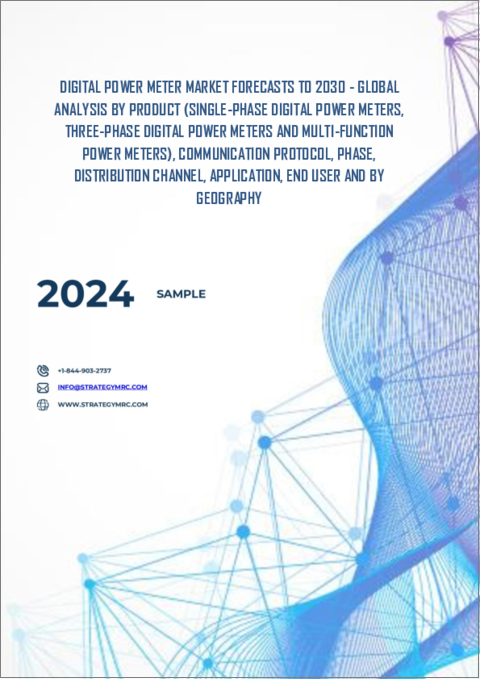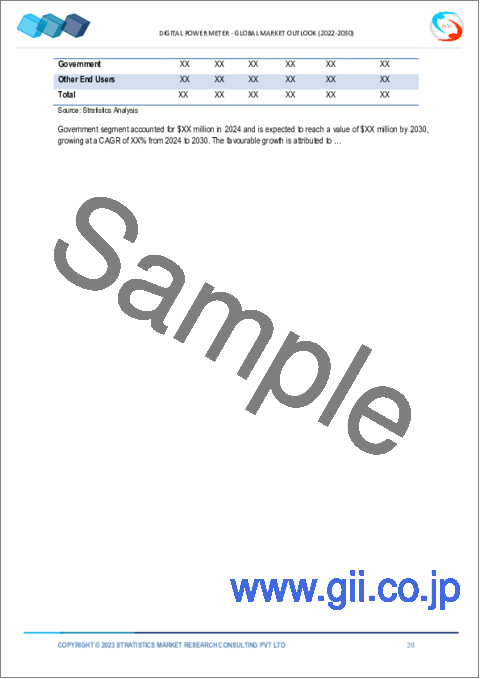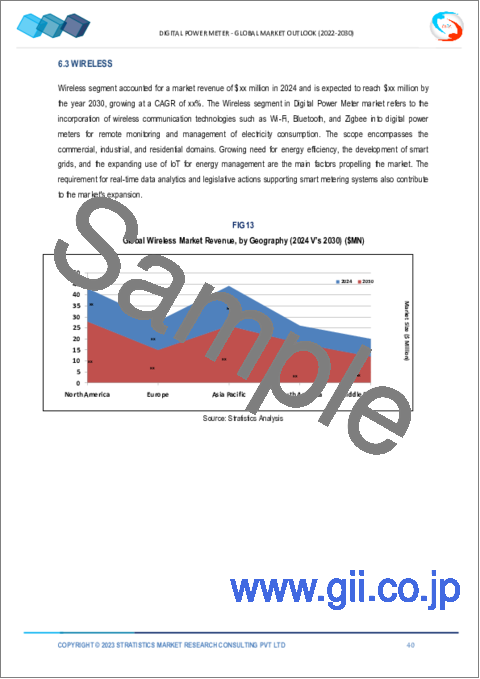|
|
市場調査レポート
商品コード
1587596
デジタルパワーメーター市場の2030年までの予測:製品別、通信プロトコル別、フェーズ別、流通チャネル別、用途別、エンドユーザー別、地域別の世界分析Digital Power Meter Market Forecasts to 2030 - Global Analysis By Product, Communication Protocol, Phase, Distribution Channel, Application, End User and By Geography |
||||||
カスタマイズ可能
|
|||||||
| デジタルパワーメーター市場の2030年までの予測:製品別、通信プロトコル別、フェーズ別、流通チャネル別、用途別、エンドユーザー別、地域別の世界分析 |
|
出版日: 2024年11月11日
発行: Stratistics Market Research Consulting
ページ情報: 英文 200+ Pages
納期: 2~3営業日
|
- 全表示
- 概要
- 図表
- 目次
Stratistics MRCによると、世界のデジタルパワーメーター市場は2024年に122億5,000万米ドルを占め、予測期間中のCAGRは14.6%で成長し、2030年には486億1,000万米ドルに達する見込みです。
デジタルパワーメーターは、電力使用量をリアルタイムで測定・表示する電子機器です。電圧、電流、力率、エネルギー消費量の正確な測定値を提供し、多くの場合、分析用にデータを保存・送信する機能を備えています。遠隔監視、プログラム可能な設定、エネルギー使用を最適化するためのビル管理システムとの統合などの高度な機能を提供します。
2022年のデータによると、米国の平均的な家庭用電力需要家の年間消費電力量は約10,791キロワット時(kWh)で、1ヵ月あたり約899kWhです。
エネルギー消費削減への世界の関心の高まり
デジタルパワーメーターは、電力使用量の正確な追跡を可能にし、消費者や企業がエネルギー消費を最適化し、無駄を省く力を与えます。政府や規制機関は、エネルギー効率化の義務付けやインセンティブ・プログラムを導入し、スマート・メーターの採用を奨励しています。さらに、太陽光や風力などの持続可能なエネルギー源への移行には、エネルギー生産と使用量を監視してバランスをとるための高度な計測技術が必要であり、デジタルパワーメーターの需要を世界的にさらに押し上げています。
サイバーセキュリティへの懸念
デジタルパワーメーターにおけるサイバーセキュリティの懸念は、インターネットやスマートグリッドシステムへの接続性から生じるもので、ハッキングやデータ侵害に対して脆弱です。不正アクセスは、エネルギー使用データの改ざん、サービスの中断、消費者のプライバシー侵害につながる可能性があります。このようなリスクは、電力会社や顧客の間に不安を生み、デジタルパワーメーター技術の採用や投資を遅らせる可能性があります。その結果、サイバー脅威への恐怖が市場の成長を妨げています。
スマートグリッドの開発
電力会社がスマートグリッドに投資するにつれて、エネルギー消費に関する正確なデータを提供し、グリッドの信頼性を高め、需要応答プログラムを促進する能力により、デジタルパワーメーターに対する需要が増加します。これらのメーターは、電力会社と消費者の双方向通信をサポートし、エネルギー効率と資源配分の改善を可能にします。さらに、再生可能エネルギー源との統合には高度な計測ソリューションが必要であり、スマートグリッドインフラとシームレスに相互作用できるデジタルパワーメーターの採用を推進しています。この要素が市場需要を加速しています。
複雑な設置プロセス
デジタルパワーメーターの複雑な設置工程は、新技術を既存の電気システムに統合する必要性から生じ、多くの場合、専門的な技能と機器を必要とします。古いインフラを改修するには、配線の変更やコンポーネントのアップグレードなど、大幅な変更が必要になる場合があり、時間とコストがかかります。この複雑さは、電力会社や消費者がデジタル・メーターを採用することを躊躇させ、展開の遅れにつながる可能性があります。また、関連するコストやロジスティクスの課題は、投資を抑制し、市場の成長を妨げる可能性があります。
COVID-19の影響
COVID-19の大流行は、ロックダウンや制限により製造やサプライチェーンの操業を遅らせ、デジタルパワーメーター市場に影響を与えました。インフラ・プロジェクトの遅れや産業活動の減少は需要の減少につながった。しかし、パンデミックは遠隔監視技術の採用を加速させ、エネルギー管理用スマートメーターへの関心を高めました。企業や公共事業が効率化と自動化を求める中、デジタルパワーメーターは遠隔地やハイブリッド作業環境でのエネルギー消費管理に不可欠となり、パンデミック後の長期需要を押し上げました。
予測期間中、電力品質監視セグメントが最大になると予測される
電力品質モニタリング分野は、予測期間を通じて最大の市場シェアを確保すると予測されています。デジタルパワーメーターは、電圧、電流、周波数、力率に関するリアルタイムデータを提供することで、電力品質モニタリングにおいて重要な役割を果たしています。これらのデバイスは、電気システムの安定性と効率性に影響を与える可能性のある変動、障害、高調波の特定に役立ちます。電力品質指標を継続的に追跡することにより、デジタルパワーメーターは公益事業や産業界が問題を診断し、システムの信頼性を維持し、ダウンタイムを削減することを可能にします。
予測期間中にCAGRが最も高くなると予測される産業用セグメント
産業用セグメントは、予測期間中に最も高いCAGRが見込まれます。産業用アプリケーションにおいて、デジタルパワーメーターは電気エネルギー消費の監視と管理において重要な役割を果たしています。デジタルパワーメーターは、電圧、電流、力率、エネルギー使用量に関するデータをリアルタイムで提供するため、産業は操業を最適化し、コストを削減することができます。デジタルパワーメーターは、非効率を特定し、エネルギー使用パターンを追跡し、エネルギー規制へのコンプライアンスを確保するために不可欠です。さらに、機器の健全性を監視することで予知保全を促進し、故障やダウンタイムの防止に役立ちます。
最大のシェアを占める地域
アジア太平洋地域は、中国、インド、日本などの国々におけるエネルギー需要の増加、都市化、工業化に牽引され、予測期間中に最大の市場シェアを記録すると予想されます。スマートグリッドやエネルギー効率化を推進する政府の取り組みや、再生可能エネルギーインフラへの投資が、市場拡大を後押しする主な要因となっています。さらに、アジア太平洋地域では、二酸化炭素排出量の削減とエネルギー管理の強化に注力しており、様々な分野でデジタルパワーメーターの需要を促進しています。
CAGRが最も高い地域:
北米は、エネルギー効率化イニシアチブの高まり、スマートグリッドの採用、老朽化したインフラの近代化により、予測期間中に最も高いCAGRを記録すると予測されています。米国とカナダが主要プレーヤーであり、エネルギー消費を最適化するために高度な計測技術の統合に注力しています。同地域では、住宅、商業、産業部門からの需要が旺盛で、電力会社はリアルタイム監視、請求精度の向上、送電網の信頼性強化のためにデジタルパワーメーターの導入を進めています。
無料カスタマイズサービス:
本レポートをご購読のお客様には、以下の無料カスタマイズオプションのいずれかをご利用いただけます:
- 企業プロファイル
- 追加市場プレーヤーの包括的プロファイリング(3社まで)
- 主要企業のSWOT分析(3社まで)
- 地域セグメンテーション
- 顧客の関心に応じた主要国の市場推計・予測・CAGR(注:フィージビリティチェックによる)
- 競合ベンチマーキング
- 製品ポートフォリオ、地理的プレゼンス、戦略的提携に基づく主要企業のベンチマーキング
目次
第1章 エグゼクティブサマリー
第2章 序文
- 概要
- ステークホルダー
- 調査範囲
- 調査手法
- データマイニング
- データ分析
- データ検証
- 調査アプローチ
- 調査情報源
- 1次調査情報源
- 2次調査情報源
- 前提条件
第3章 市場動向分析
- 促進要因
- 抑制要因
- 機会
- 脅威
- 製品分析
- 用途分析
- エンドユーザー分析
- 新興市場
- COVID-19の影響
第4章 ポーターのファイブフォース分析
- 供給企業の交渉力
- 買い手の交渉力
- 代替品の脅威
- 新規参入業者の脅威
- 競争企業間の敵対関係
第5章 世界のデジタルパワーメーター市場:製品別
- 単相デジタルパワーメーター
- 三相デジタルパワーメーター
- 多機能パワーメーター
第6章 世界のデジタルパワーメーター市場:通信プロトコル別
- 有線
- Ethernet
- 電力線通信(PLC)
- 無線
- Zigbee
- Wi-Fi
- セルラー
第7章 世界のデジタルパワーメーター市場:フェーズ別
- 低電圧
- 中電圧
- 高電圧
第8章 世界のデジタルパワーメーター市場:流通チャネル別
- 直接販売
- 販売代理店
- オンライン販売
- その他の流通チャネル
第9章 世界のデジタルパワーメーター市場:用途別
- 電力品質監視
- 負荷管理
- エネルギーコスト会計
- ネットワーク保護
- 請求と収益回収
- その他の用途
第10章 世界のデジタルパワーメーター市場:エンドユーザー別
- 住宅
- 商業
- 産業
- 電力会社
- 製造業
- データセンター
- 輸送機関
- ヘルスケア
- 政府
- その他のエンドユーザー
第11章 世界のデジタルパワーメーター市場:地域別
- 北米
- 米国
- カナダ
- メキシコ
- 欧州
- ドイツ
- 英国
- イタリア
- フランス
- スペイン
- その他欧州
- アジア太平洋
- 日本
- 中国
- インド
- オーストラリア
- ニュージーランド
- 韓国
- その他アジア太平洋地域
- 南米
- アルゼンチン
- ブラジル
- チリ
- その他南米
- 中東・アフリカ
- サウジアラビア
- アラブ首長国連邦
- カタール
- 南アフリカ
- その他中東とアフリカ
第12章 主な発展
- 契約、パートナーシップ、コラボレーション、合弁事業
- 買収と合併
- 新製品発売
- 事業拡大
- その他の主要戦略
第13章 企業プロファイリング
- Schneider Electric
- Siemens AG
- General Electric Company
- ABB Limited
- Honeywell International Inc.
- Itron Inc.
- Landis+Gyr
- Eaton Corporation
- Mitsubishi Electric Corporation
- Wasion Group Holdings Limited
- Schweitzer Engineering Laboratories Inc.
- Holley Technology Limited
- Xylem Corporation
- Emerson Electric Corporation
- Kamstrup
- Aclara Technologies LLC
- Iskraemeco
- EDMI Limited
List of Tables
- Table 1 Global Digital Power Meter Market Outlook, By Region (2022-2030) ($MN)
- Table 2 Global Digital Power Meter Market Outlook, By Product (2022-2030) ($MN)
- Table 3 Global Digital Power Meter Market Outlook, By Single-Phase Digital Power Meters (2022-2030) ($MN)
- Table 4 Global Digital Power Meter Market Outlook, By Three-Phase Digital Power Meters (2022-2030) ($MN)
- Table 5 Global Digital Power Meter Market Outlook, By Multi-Function Power Meters (2022-2030) ($MN)
- Table 6 Global Digital Power Meter Market Outlook, By Communication Protocol (2022-2030) ($MN)
- Table 7 Global Digital Power Meter Market Outlook, By Wired (2022-2030) ($MN)
- Table 8 Global Digital Power Meter Market Outlook, By Ethernet (2022-2030) ($MN)
- Table 9 Global Digital Power Meter Market Outlook, By Powerline Communication (PLC) (2022-2030) ($MN)
- Table 10 Global Digital Power Meter Market Outlook, By Wireless (2022-2030) ($MN)
- Table 11 Global Digital Power Meter Market Outlook, By Zigbee (2022-2030) ($MN)
- Table 12 Global Digital Power Meter Market Outlook, By Wi-Fi (2022-2030) ($MN)
- Table 13 Global Digital Power Meter Market Outlook, By Cellular (2022-2030) ($MN)
- Table 14 Global Digital Power Meter Market Outlook, By Phase (2022-2030) ($MN)
- Table 15 Global Digital Power Meter Market Outlook, By Low Voltage (2022-2030) ($MN)
- Table 16 Global Digital Power Meter Market Outlook, By Medium Voltage (2022-2030) ($MN)
- Table 17 Global Digital Power Meter Market Outlook, By High Voltage (2022-2030) ($MN)
- Table 18 Global Digital Power Meter Market Outlook, By Distribution Channel (2022-2030) ($MN)
- Table 19 Global Digital Power Meter Market Outlook, By Direct Sales (2022-2030) ($MN)
- Table 20 Global Digital Power Meter Market Outlook, By Distributors (2022-2030) ($MN)
- Table 21 Global Digital Power Meter Market Outlook, By Online Sales (2022-2030) ($MN)
- Table 22 Global Digital Power Meter Market Outlook, By Other Distribution Channels (2022-2030) ($MN)
- Table 23 Global Digital Power Meter Market Outlook, By Application (2022-2030) ($MN)
- Table 24 Global Digital Power Meter Market Outlook, By Power Quality Monitoring (2022-2030) ($MN)
- Table 25 Global Digital Power Meter Market Outlook, By Load Management (2022-2030) ($MN)
- Table 26 Global Digital Power Meter Market Outlook, By Energy Cost Accounting (2022-2030) ($MN)
- Table 27 Global Digital Power Meter Market Outlook, By Network Protection (2022-2030) ($MN)
- Table 28 Global Digital Power Meter Market Outlook, By Billing & Revenue Collection (2022-2030) ($MN)
- Table 29 Global Digital Power Meter Market Outlook, By Other Applications (2022-2030) ($MN)
- Table 30 Global Digital Power Meter Market Outlook, By End User (2022-2030) ($MN)
- Table 31 Global Digital Power Meter Market Outlook, By Residential (2022-2030) ($MN)
- Table 32 Global Digital Power Meter Market Outlook, By Commercial (2022-2030) ($MN)
- Table 33 Global Digital Power Meter Market Outlook, By Industrial (2022-2030) ($MN)
- Table 34 Global Digital Power Meter Market Outlook, By Power Utilities (2022-2030) ($MN)
- Table 35 Global Digital Power Meter Market Outlook, By Manufacturing (2022-2030) ($MN)
- Table 36 Global Digital Power Meter Market Outlook, By Data Centers (2022-2030) ($MN)
- Table 37 Global Digital Power Meter Market Outlook, By Transportation (2022-2030) ($MN)
- Table 38 Global Digital Power Meter Market Outlook, By Healthcare (2022-2030) ($MN)
- Table 39 Global Digital Power Meter Market Outlook, By Government (2022-2030) ($MN)
- Table 40 Global Digital Power Meter Market Outlook, By Other End Users (2022-2030) ($MN)
Note: Tables for North America, Europe, APAC, South America, and Middle East & Africa Regions are also represented in the same manner as above.
According to Stratistics MRC, the Global Digital Power Meter Market is accounted for $12.25 billion in 2024 and is expected to reach $48.61 billion by 2030 growing at a CAGR of 14.6% during the forecast period. A digital power meter is an electronic device that measures and displays electrical power usage in real-time. It provides accurate readings of voltage, current, power factor, and energy consumption, often with the ability to store and transmit data for analysis. They offer advanced features such as remote monitoring, programmable settings, and integration with building management systems to optimize energy use.
According to 2022 data, the average U.S. residential electric utility customer consumed around 10,791 kilowatt-hours (kWh) annually, or approximately 899 kWh per month.
Market Dynamics:
Driver:
Growing global focus on reducing energy consumption
Digital power meters enable precise tracking of electricity usage, empowering consumers and businesses to optimize energy consumption and reduce wastage. Governments and regulatory bodies are introducing energy efficiency mandates and incentive programs, encouraging the adoption of smart meters. Additionally, the transition to sustainable energy sources, such as solar and wind, requires advanced metering technologies to monitor and balance energy production and usage, further boosting the demand for digital power meters globally.
Restraint:
Cybersecurity concerns
Cybersecurity concerns in digital power meters arise from their connectivity to the internet and smart grid systems, making them vulnerable to hacking and data breaches. Unauthorized access can lead to tampering with energy usage data, disruption of services, and privacy violations for consumers. These risks create apprehension among utilities and customers, potentially delaying adoption and investment in digital power meter technologies. As a result, the fear of cyber threats hampers market growth.
Opportunity:
Smart grid development
As utilities invest in smart grids, the demand for digital power meters increases due to their ability to provide accurate data on energy consumption, enhance grid reliability, and facilitate demand response programs. These meters support two-way communication between utilities and consumers, allowing for better energy efficiency and resource allocation. Furthermore, integration with renewable energy sources requires sophisticated metering solutions, driving the adoption of digital power meters that can seamlessly interact with smart grid infrastructure. This element accelerates the market demand.
Threat:
Complex installation processes
Complex installation processes for digital power meters arise from the need to integrate new technology with existing electrical systems, often requiring specialized skills and equipment. Retrofitting older infrastructure can involve significant modifications, such as rewiring and upgrading components, which can be time-consuming and costly. This complexity can deter utilities and consumers from adopting digital meters, leading to delays in deployment. As well as the associated costs and logistical challenges may discourage investment and impede the market growth.
Covid-19 Impact
The covid-19 pandemic impacted the digital power meter market by slowing manufacturing and supply chain operations due to lockdowns and restrictions. Delays in infrastructure projects and reduced industrial activities led to decreased demand. However, the pandemic accelerated the adoption of remote monitoring technologies, driving interest in smart meters for energy management. As businesses and utilities sought efficiency and automation, digital power meters became essential for managing energy consumption in remote and hybrid work environments, boosting long-term demand post-pandemic.
The power quality monitoring segment is expected to be the largest during the forecast period
The power quality monitoring segment is predicted to secure the largest market share throughout the forecast period. Digital power meters play a crucial role in power quality monitoring by providing real-time data on voltage, current, frequency, and power factor. These devices help identify fluctuations, disturbances, and harmonics that can affect the stability and efficiency of electrical systems. By continuously tracking power quality metrics, digital power meters enable utilities and industries to diagnose issues, maintain system reliability, and reduce downtime.
The industrial segment is expected to have the highest CAGR during the forecast period
The industrial segment is anticipated to witness the highest CAGR during the forecast period. In industrial applications, digital power meters play a crucial role in monitoring and managing electrical energy consumption. They provide real-time data on voltage, current, power factor, and energy usage, enabling industries to optimize their operations and reduce costs. Digital power meters are essential for identifying inefficiencies, tracking energy usage patterns, and ensuring compliance with energy regulations. Additionally, they facilitate predictive maintenance by monitoring equipment health, helping to prevent failures and downtime.
Region with largest share:
Asia Pacific is expected to register the largest market share during the forecast period driven by rising energy demand, urbanization, and industrialization in countries like China, India, and Japan. Government initiatives promoting smart grids and energy efficiency, along with investments in renewable energy infrastructure, are key factors boosting market expansion. Additionally, Asia-Pacific's focus on reducing carbon emissions and enhancing energy management is fueling demand for digital power meters across various sectors.
Region with highest CAGR:
North America is projected to witness the highest CAGR over the forecast period fuelled by rising energy efficiency initiatives, smart grid adoption, and modernization of aging infrastructure. The U.S. and Canada are key players, focusing on integrating advanced metering technologies to optimize energy consumption. The region is witnessing strong demand from residential, commercial, and industrial sectors, with utilities increasingly deploying digital power meters for real-time monitoring, improved billing accuracy, and enhanced grid reliability across the region.
Key players in the market
Some of the key players profiled in the Digital Power Meter Market include Schneider Electric, Siemens AG, General Electric Company, ABB Limited, Honeywell International Inc., Itron Inc., Landis+Gyr, Eaton Corporation, Mitsubishi Electric Corporation, Wasion Group Holdings Limited, Schweitzer Engineering Laboratories Inc., Holley Technology Limited, Xylem Corporation, Emerson Electric Corporation, Kamstrup, Aclara Technologies LLC, Iskraemeco and EDMI Limited.
Key Developments:
In September 2024, Itron introduced its AMI 7 Series smart electricity meter, designed to meet the increasing complexity of modern energy demands. The AMI 7 Series meters provide real-time data, enabling utilities to predict and prevent grid failures, balance energy loads, and integrate distributed energy resources (DERs) more efficiently. This ensures that as renewable energy contributions and EV charging increase, the grid can handle fluctuating energy demands while minimizing outages or instability.
In August 2024, Siemens introduced the Sentron PAC3200 digital power meter, designed specifically for industrial applications requiring precise power quality monitoring. The PAC3200 model offers comprehensive measurement of electrical parameters, such as voltage, current, power, and energy consumption. Its focus on accuracy and reliability ensures that industries can better monitor and optimize their energy usage.
In July 2024, Landis+Gyr introduced its Gridstream Connect Meters, an innovative solution designed to enhance utility infrastructure, particularly for smart cities. These meters feature advanced two-way communication, enabling real-time data transfer between utilities and customers. This integration helps utilities improve operational efficiency, reduce costs, and enhance resource management by offering better visibility into usage patterns across all services.
Products Covered:
- Single-Phase Digital Power Meters
- Three-Phase Digital Power Meters
- Multi-Function Power Meters
Communication Protocols Covered:
- Wired
- Wireless
Phases Covered:
- Low Voltage
- Medium Voltage
- High Voltage
Distribution Channels Covered:
- Direct Sales
- Distributors
- Online Sales
- Other Distribution Channels
Applications Covered:
- Power Quality Monitoring
- Load Management
- Energy Cost Accounting
- Network Protection
- Billing & Revenue Collection
- Other Applications
End Users Covered:
- Residential
- Commercial
- Industrial
- Transportation
- Healthcare
- Government
- Other End Users
Regions Covered:
- North America
- US
- Canada
- Mexico
- Europe
- Germany
- UK
- Italy
- France
- Spain
- Rest of Europe
- Asia Pacific
- Japan
- China
- India
- Australia
- New Zealand
- South Korea
- Rest of Asia Pacific
- South America
- Argentina
- Brazil
- Chile
- Rest of South America
- Middle East & Africa
- Saudi Arabia
- UAE
- Qatar
- South Africa
- Rest of Middle East & Africa
What our report offers:
- Market share assessments for the regional and country-level segments
- Strategic recommendations for the new entrants
- Covers Market data for the years 2022, 2023, 2024, 2026, and 2030
- Market Trends (Drivers, Constraints, Opportunities, Threats, Challenges, Investment Opportunities, and recommendations)
- Strategic recommendations in key business segments based on the market estimations
- Competitive landscaping mapping the key common trends
- Company profiling with detailed strategies, financials, and recent developments
- Supply chain trends mapping the latest technological advancements
Free Customization Offerings:
All the customers of this report will be entitled to receive one of the following free customization options:
- Company Profiling
- Comprehensive profiling of additional market players (up to 3)
- SWOT Analysis of key players (up to 3)
- Regional Segmentation
- Market estimations, Forecasts and CAGR of any prominent country as per the client's interest (Note: Depends on feasibility check)
- Competitive Benchmarking
- Benchmarking of key players based on product portfolio, geographical presence, and strategic alliances
Table of Contents
1 Executive Summary
2 Preface
- 2.1 Abstract
- 2.2 Stake Holders
- 2.3 Research Scope
- 2.4 Research Methodology
- 2.4.1 Data Mining
- 2.4.2 Data Analysis
- 2.4.3 Data Validation
- 2.4.4 Research Approach
- 2.5 Research Sources
- 2.5.1 Primary Research Sources
- 2.5.2 Secondary Research Sources
- 2.5.3 Assumptions
3 Market Trend Analysis
- 3.1 Introduction
- 3.2 Drivers
- 3.3 Restraints
- 3.4 Opportunities
- 3.5 Threats
- 3.6 Product Analysis
- 3.7 Application Analysis
- 3.8 End User Analysis
- 3.9 Emerging Markets
- 3.10 Impact of Covid-19
4 Porters Five Force Analysis
- 4.1 Bargaining power of suppliers
- 4.2 Bargaining power of buyers
- 4.3 Threat of substitutes
- 4.4 Threat of new entrants
- 4.5 Competitive rivalry
5 Global Digital Power Meter Market, By Product
- 5.1 Introduction
- 5.2 Single-Phase Digital Power Meters
- 5.3 Three-Phase Digital Power Meters
- 5.4 Multi-Function Power Meters
6 Global Digital Power Meter Market, By Communication Protocol
- 6.1 Introduction
- 6.2 Wired
- 6.2.1 Ethernet
- 6.2.2 Powerline Communication (PLC)
- 6.3 Wireless
- 6.3.1 Zigbee
- 6.3.2 Wi-Fi
- 6.3.3 Cellular
7 Global Digital Power Meter Market, By Phase
- 7.1 Introduction
- 7.2 Low Voltage
- 7.3 Medium Voltage
- 7.4 High Voltage
8 Global Digital Power Meter Market, By Distribution Channel
- 8.1 Introduction
- 8.2 Direct Sales
- 8.3 Distributors
- 8.4 Online Sales
- 8.5 Other Distribution Channels
9 Global Digital Power Meter Market, By Application
- 9.1 Introduction
- 9.2 Power Quality Monitoring
- 9.3 Load Management
- 9.4 Energy Cost Accounting
- 9.5 Network Protection
- 9.6 Billing & Revenue Collection
- 9.7 Other Applications
10 Global Digital Power Meter Market, By End User
- 10.1 Introduction
- 10.2 Residential
- 10.3 Commercial
- 10.4 Industrial
- 9.4.1 Power Utilities
- 9.4.2 Manufacturing
- 9.4.3 Data Centers
- 10.5 Transportation
- 10.6 Healthcare
- 10.7 Government
- 10.8 Other End Users
11 Global Digital Power Meter Market, By Geography
- 11.1 Introduction
- 11.2 North America
- 11.2.1 US
- 11.2.2 Canada
- 11.2.3 Mexico
- 11.3 Europe
- 11.3.1 Germany
- 11.3.2 UK
- 11.3.3 Italy
- 11.3.4 France
- 11.3.5 Spain
- 11.3.6 Rest of Europe
- 11.4 Asia Pacific
- 11.4.1 Japan
- 11.4.2 China
- 11.4.3 India
- 11.4.4 Australia
- 11.4.5 New Zealand
- 11.4.6 South Korea
- 11.4.7 Rest of Asia Pacific
- 11.5 South America
- 11.5.1 Argentina
- 11.5.2 Brazil
- 11.5.3 Chile
- 11.5.4 Rest of South America
- 11.6 Middle East & Africa
- 11.6.1 Saudi Arabia
- 11.6.2 UAE
- 11.6.3 Qatar
- 11.6.4 South Africa
- 11.6.5 Rest of Middle East & Africa
12 Key Developments
- 12.1 Agreements, Partnerships, Collaborations and Joint Ventures
- 12.2 Acquisitions & Mergers
- 12.3 New Product Launch
- 12.4 Expansions
- 12.5 Other Key Strategies
13 Company Profiling
- 13.1 Schneider Electric
- 13.2 Siemens AG
- 13.3 General Electric Company
- 13.4 ABB Limited
- 13.5 Honeywell International Inc.
- 13.6 Itron Inc.
- 13.7 Landis+Gyr
- 13.8 Eaton Corporation
- 13.9 Mitsubishi Electric Corporation
- 13.10 Wasion Group Holdings Limited
- 13.11 Schweitzer Engineering Laboratories Inc.
- 13.12 Holley Technology Limited
- 13.13 Xylem Corporation
- 13.14 Emerson Electric Corporation
- 13.15 Kamstrup
- 13.16 Aclara Technologies LLC
- 13.17 Iskraemeco
- 13.18 EDMI Limited





